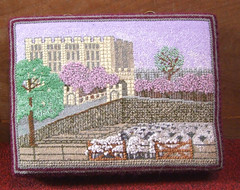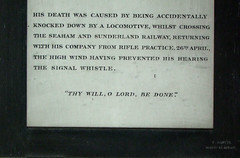| |
|
St
Andrew, Congham
 |
|
The
further north you journey from the Brecklands,
the lovelier the villages get. St Andrew is a
pretty little church in the quiet lanes south of
the Sandringham estate. The tower appears to be
entirely from before the Black Death. Pevsner
mentions a bequest of 1446 for 'emendation to the
tower', which may well have been just a repair
job, indistinguishable to us today. The area
between Kings Lynn and Swaffham was knocked back
hard by the pestilence of the mid-14th Century,
and didn't really recover until the 19th Century.
It is noticeable that grand late-medieval
statements in this area are few and far between,
though they do exist. The nave
and chancel are a hotch-potch of various
centuries - more 'emendations', one assumes, but
internally it is the substantial 19th Century
restoration which gives St Andrew all of its
character. There was probably a fair bit for the
Victorians to do, and they did it well,
preserving the feel of a rural church but
including some high notes of triumph.
|
It is not
all entirely modern. There is one of those panelled
Purbeck marble fonts of the 13th Century, and there is
also some surviving medieval and Jacobean woodwork built
together to form a tower screen. The Jacobean work was
probably panelling, but it is hard to say exactly where
the medieval work came from. The lower part is almost
certainly from the top of the rood screen, but the
unusual design of the upper part suggests it might once
have been an upright rather than horizontal. However,
they appear parts of the same piece of wood. A puzzle.
Nothing
else is old. But there is a charm to the interior, a
pleasing warmth. The star of the show is probably the set
of kneelers - not a phrase I ever thought I'd write, but
they are certainly the most splendid I've seen in a
Norfolk church.They were designed by a local woman, Joan
Ross, and made by members of the Embroiderers Guild and
the West Norfolk needleworkers as a memorial to a local
embroiderer, Susan Gurney. They depict scenes pertinent
to her, as well as more general Norfolk church and
country life. The parish are obviously very proud of
them.
Up in the
chancel, I liked very much the memorial on the south
chancel wall which records that Elsden Peter Harvey
Everard was accidentally knocked down by a locomotive
whilst crossing the Seaham and Sunderland railway,
returning with his company from rifle practice, the high
wind having prevented his hearing the signal whistle.
| The
pulpit is a handsome piece. It was produced by
the Royal Carving Workshop on the Sandringham
estate in the 1890s, and has the suitably serious
quality of the decade. It is noticeable as you
travel around this area how many of its churches
underwent high quality improvements in the ten
years either side of the new century, as the
Prince of Wales, and then King, went about
restoring the local villages of what had been one
of the poorest areas of England. Perhaps the
workshop was also responsible for the reredos. Outside in
the churchyard I spotted a name from my
childhood, the journalist Tony Scase, who died in
1994. He was a regular presenter on East Anglian
television for both BBC East and Anglia TV, and
in his lifetime he was a supporter of Congham
church.
|
|
 |
|
|
|
